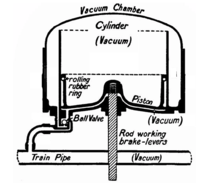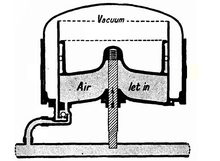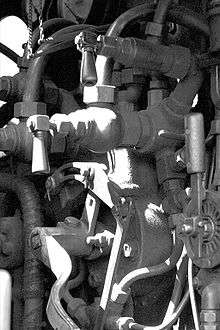Vacuum brake
The vacuum brake is a braking system employed on trains and introduced in the mid-1860s. A variant, the automatic vacuum brake system, became almost universal in British train equipment and in countries influenced by British practice. Vacuum brakes also enjoyed a brief period of adoption in the United States, primarily on narrow gauge railroads. Its limitations caused it to be progressively superseded by compressed air systems starting in the United Kingdom from the 1970s onward. The vacuum brake system is now obsolete; it is not in large-scale usage anywhere in the world, other than in South Africa, largely supplanted by air brakes.
Introduction
In the earliest days of railways, trains were slowed or stopped by the application of manually applied brakes on the locomotive and in brake vehicles through the train, and later by steam power brakes on locomotives. This was clearly unsatisfactory, but the existing technology did not offer an improvement. A chain braking system was developed, requiring a chain to be coupled throughout the train, but it was impossible to arrange equal braking effort along the entire train.
A major advance was the adoption of a vacuum braking system, in which flexible pipes were connected between all the vehicles of the train, and brakes on each vehicle could be controlled from the locomotive. The earliest scheme was a simple vacuum brake, in which vacuum was created by operation of a valve on the locomotive; the vacuum actuated brake pistons on each vehicle, and the degree of braking could be increased or decreased by the driver. Vacuum, rather than compressed air, was preferred because steam locomotives can be fitted with ejectors; venturi devices that create vacuum without moving parts.
The simple vacuum system had the major defect that in the event of one of the hoses connecting the vehicles becoming displaced (by the train accidentally dividing, or by careless coupling of the hoses, or otherwise) the vacuum brake on the entire train was useless.
The automatic vacuum brake had been developed: it was designed to apply fully if the train becomes divided or if a hose becomes displaced, but opposition on the grounds of cost (particularly by the LNWR and its chairman Richard Moon) to the fitting of the automatic type of brake meant that it took a serious accident at Armagh in 1889 before legislation compelled the automatic system. In this accident at Armagh, a portion of a train was detached from the locomotive on a steep gradient and ran away, killing 80 people.[1] The train was fitted with the simple vacuum brake, which was useless on the disconnected portion of the train. It was clear that if the vehicles had been fitted with an automatic continuous brake, the accident would almost certainly not have happened, and the public concern at the scale of the accident prompted legislation mandating the use of a continuous automatic brake on all passenger trains.
How the automatic vacuum brake works


In its simplest form, the automatic vacuum brake consists of a continuous pipe—the train pipe—running throughout the length of the train. In normal running a partial vacuum is maintained in the train pipe, and the brakes are released. When air is admitted to the train pipe, the air pressure acts against pistons in cylinders in each vehicle. A vacuum is sustained on the other face of the pistons, so that a net force is applied. A mechanical linkage transmits this force to brake shoes which act on the treads of the wheels.
The fittings to achieve this are:
- a train pipe: a steel pipe running the length of each vehicle, with flexible vacuum hoses at each end of the vehicles, and coupled between adjacent vehicles; at the end of the train, the final hose is seated on an air-tight plug;
- an ejector on the locomotive, to create vacuum in the train pipe;
- controls for the driver to bring the ejector into action, and to admit air to the train pipe; these may be separate controls or a combined brake valve;
- a brake cylinder on each vehicle containing a piston, connected by rigging to the brake shoes on the vehicle; and
- a vacuum (pressure) gauge on the locomotive to indicate to the driver the degree of vacuum in the train pipe.
The brake cylinder is contained in a larger housing—this gives a reserve of vacuum as the piston operates. The cylinder rocks slightly in operation to maintain alignment with the brake rigging cranks, so it is supported in trunnion bearings, and the vacuum pipe connection to it is flexible. The piston in the brake cylinder has a flexible piston ring that allows air to pass from the upper part of the cylinder to the lower part if necessary.
When the vehicles have been at rest, so that the brake is not charged, the brake pistons will have dropped to their lower position in the absence of a pressure differential (as air will have leaked slowly into the upper part of the cylinder, destroying the vacuum).
When a locomotive is coupled to the vehicles, the driver moves the brake control to the "release" position and air is exhausted from the train pipe, creating a partial vacuum. Air in the upper part of the brake cylinders is also exhausted from the train pipe, through a non-return valve.
If the driver now moves his control to the "brake" position, air is admitted to the train pipe. According to the driver's manipulation of the control, some or all of the vacuum will be destroyed in the process. The ball valve closes and there is a higher air pressure under the brake pistons than above it, and the pressure differential forces the piston upwards, applying the brakes. The driver can control the amount of braking effort by admitting more or less air to the train pipe.
Practical considerations
The automatic vacuum brake as described represented a considerable technical advance in train braking. In practice steam locomotives had two ejectors, a small ejector for running purposes (to exhaust air that had leaked into the train pipe) and a large ejector to release brake applications. Later Great Western Railway practice was to use a vacuum pump instead of the small ejector.

The driver's brake valve was usually combined with the steam brake control on the locomotive.
Release valves are provided on the brake cylinders; when operated, usually by manually pulling a cord near the cylinder, air is admitted to the upper part of the brake cylinder on that vehicle. This is necessary to release the brake on a vehicle that has been uncoupled from a train and now requires to be moved without having a brake connection to another locomotive, for example if it is to be shunted.
In the UK the pre-nationalisation railway companies standardised around systems operating on a vacuum of 21 inches of mercury (533.4 Torr), with the exception of the Great Western Railway, which used 25 inches of mercury (635 Torr). An absolute vacuum is about 30 inches of mercury (760 Torr), depending on atmospheric conditions.
This difference in standards could cause problems on long distance cross-country services when a GWR locomotive was replaced with another company's engine, as the new engine's large ejector would sometimes not be able to fully release the brakes on the train. In this case the release valves on each vehicle in the train would have to be released by hand, before the brake was recharged at 21 inches. This time consuming process was frequently seen at large GWR stations such as Bristol Temple Meads.
The provision of a train pipe running throughout the train enabled the automatic vacuum brake to be operated in emergency from any position in the train. Every guard's compartment had a brake valve, and the passenger communication apparatus (usually called "the communication cord" in lay terminology) also admitted air into the train pipe at the end of coaches so equipped.
When a locomotive is first coupled to a train, or if a vehicle is detached or added, a brake continuity test is carried out, to ensure that the brake pipes are connected throughout the entire length of the train.
Limitations
The progress represented by the automatic vacuum brake nonetheless carried some limitations; chief among these were:
- the practical limit on the degree of vacuum attainable means that a very large brake piston and cylinder are required to generate the force necessary on the brake blocks; when a proportion of the British ordinary wagon fleet was fitted with vacuum brakes in the 1950s, the physical dimensions of the brake cylinder prevented the wagons from operating in some private sidings that had tight clearances;
- for the same reason, on a very long train, a considerable volume of air has to be admitted to the train pipe to make a full brake application, and a considerable volume has to be exhausted to release the brake (if for example a signal at danger is suddenly lowered and the driver requires to resume speed); while the air is traveling along the train pipe, the brake pistons at the head of the train have responded to the brake application or release, but those at the tail will respond much later, leading to undesirable longitudinal forces in the train. In extreme cases this has led to breaking couplings and causing the train to divide.
- the existence of vacuum in the train pipe can cause debris to be sucked in. An accident took place near Ilford in the 1950s, due to inadequate braking effort in the train. A rolled newspaper was discovered in the train pipe, effectively isolating the rear part of the train from the driver's control. The blockage should have been detected if a proper brake continuity test had been carried out before the train started its journey.
A development introduced in the 1950s was the direct admission valve, fitted to every brake cylinder. These valves responded to a rise in train pipe pressure as the brake was applied, and admitted atmospheric air directly to the underside of the brake cylinder.
American and continental European practice had long favoured compressed air brake systems, the leading pattern being a proprietary Westinghouse system. This has a number of advantages, including smaller brake cylinders (because higher air pressure could be used) and a somewhat more responsive braking effort. However, the system requires an air pump. On steam engines this was usually a reciprocating steam pump, which was quite bulky. Its distinctive shape and the characteristic puffing sound when the brake is released (as the train pipe has to be recharged with air) make steam locomotives fitted with the Westinghouse brake unmistakable. Another disadvantage of the earlier air brake systems (although later overcome) was that it was impossible to make a partial release. The vacuum brake can very simply be partially released by restoring some (but not all) of the vacuum, without having to fully release the brakes. The original air brake systems, on the other hand, did not allow this, the only way of partially releasing the brake being to fully release it, then re-apply it to the desired setting.
In the UK, the Great Eastern Railway, the North Eastern Railway, the London Brighton and South Coast Railway and the Caledonian Railway adopted the Westinghouse system. It was also standard on the Isle of Wight rail system. This led to compatibility problems in exchanging traffic with other lines. It was possible to provide through pipes for the braking system not fitted to any particular vehicle so that it could run in a train using the "other" system, allowing through control of the fitted vehicles behind it, but with no braking effort of its own; or to fit vehicles with both braking systems.
Dual brakes
The Vehicles can be fitted with dual brakes, vacuum and air, provided that there is room to fit the duplicated equipment. In a dual fitted vehicle, there would be both a vacuum cylinder and one or more air brake cylinders, all operating on the same set of rigging to apply the brakes at the vehicle wheels. Some of BR's Mk1 coaches were built with dual brakes (all had vacuum as standard) and much of the rest of the fleet was dual fitted by the 1980s, so they could be worked by air or vacuum fitted locomotives as the changeover from vacuum to air took place between 1970 and the early 1990s.
On a smaller vehicle such as a traditional four-wheeled goods wagon, it is much easier to fit just one kind of brake with a pipe for continuity of the other. Train crew need to take note that the wrong-fitted wagons do not contribute to the braking effort and make allowances on down grades to suit. Many of the earlier classes of diesel locomotive used on British Railways (and electric locos up to and including the Class 86) were fitted with dual systems to enable full usage of BR's rolling stock inherited from the private companies which had different systems depending on which company the stock originated from.
Air brakes need a tap to seal the hose at the ends of the train. If these taps are incorrectly closed, a loss of brake force may occur, leading to a dangerous runaway. With vacuum brakes, the end of the hose can be plugged into a stopper which seals the hose by suction. It is much harder to block the hose pipe compared to air brakes.
Twin pipe systems
Vacuum brakes can be operated in a twin pipe mode to speed up applications and release.[2] Twin pipe vacuum systems were standard on the 1st generation British Rail Diesel Multiple Units which replaced steam locomotive hauled passenger trains on many branch and secondary lines in the 1960s.
Present-day use of vacuum brakes
Today's largest operators of trains equipped with vacuum brakes are the Indian Railways and Spoornet (South Africa), however there are also trains with air brakes and dual brakes in use. South African Railways (Spoornet) operates more than 1 000 electric multiple unit cars, which are fitted with air compressed brakes. The electro-vacuum system uses a 2-inch (51 mm) train pipe and basic automatic vacuum brake system, with the addition of electrically-controlled application and release valves in each vehicle. The application and release valves greatly increase the rate of train pipe vacuum destruction and creation. This, in turn, greatly increases the speed of brake application and release. The performance of electro-vacuum brakes on SAR EMUs is equivalent to electro-pneumatic braked EMUs of a similar age.
Other African railways are believed to continue to use the vacuum brake. Other operators of vacuum brakes are narrow gauge railways in Europe, the largest of which is the Rhaetian Railway.
Vacuum brakes have been entirely superseded on the National Rail system in the UK apart from on the remaining class 121 diesel railcars, although they are still in use on most standard gauge heritage railways. They are also to be found on a diminishing number of main line vintage special trains.
Iarnród Éireann (the national rail operator in the Republic of Ireland) ran vacuum-braked British Railways Mark 2 stock on passenger trains until the end of March 2008[3] and still operates vacuum-braked revenue freight (at least in the case of Tara Mines ore traffic). All mainline heritage trains are run with vacuum brakes - the whole of Iarnród Éireann's current locomotive fleet has both air and vacuum train brakes fitted.
The Isle of Man Railway, which is a steam railway operated mainly using a mixture of Beyer Peacock 2-4-0 tanks and a Dubs 0-6-0 (and some diesel stock), exclusively operates the vacuum brake system, which is fitted to all its coaching and wagon stock.
High altitude
Vacuum brakes are less effective at high altitude. This is because they depend upon the creation of a pressure differential; atmospheric pressure is lower at high altitudes, and so the maximum differential is also lower.
See also
References
- ↑ Currie, J.R.L. (1971). The Runaway Train: Armagh 1889. Newton Abbot: David & Charles. pp. 109, 129–130. ISBN 0-7153-5198-2.
- ↑ Twin Pipe Dual Brake System
- ↑ "Rolling Stock". Journal of the Irish Railway Record Society. 23 (166): 312–3. June 2008.
- British Transport Commission, London (1957:142). Handbook for Railway Steam Locomotive Enginemen.
External links
- Winchester, Clarence, ed. (1936). "The vacuum automatic brake". Railway Wonders of the World. pp. 386–391. illustrated description of the vacuum automatic brake